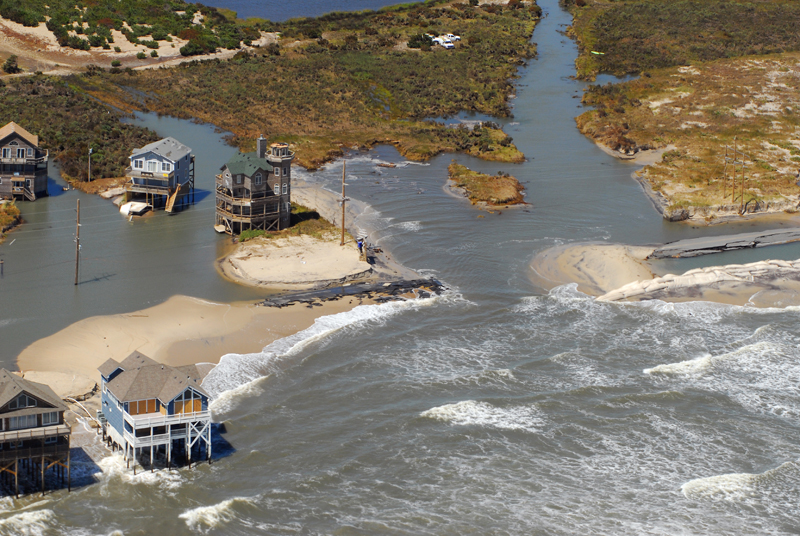Excerpt:
The inlet was coming. For more than 15 years, Mason Inlet had been marauding south, approaching the structures at the north end of North Carolina’s Wrightsville Beach. It had already carved away hundreds of acres of sandy spit, a public parking lot, and the land that was home to the temporary beach house used in Julia Robert’s 1991 film “Sleeping with the Enemy.”
By the early 2000s, it was just yards from the nine-story Shell Island Resort, only stopped by a line of large sandbags.
Faced with letting one of Wrightsville Beach’s signature structures wash away or cobbling together a funding package to move the inlet, the New Hanover County Commissioners chose the latter. The county would relocate the inlet 3,000 feet to the north with property owners at the north end of Wrightsville Beach and those on Figure Eight Island, a wealthy private enclave on the other side of the inlet, assessed a special assessment to repay the $6.5-million relocation cost and future maintenance costs.
More than two decades after the 2002 relocation project, the inlet remains stably and safely away from threatening the expensive beachfront properties on either side of the waterway.
Along coastal North Carolina, engineering answers to threats from Mother Nature is a time-honored tradition to dealing with eroding beaches and threats from wandering inlets.
But pumping sand isn’t cheap. It also is becoming a scarce commodity along some parts of the North Carolina coast. Moving waterways or building hardened structures, like terminal groins, also can break the budgets of many local beach communities that don’t have the deep pockets of a Wrightsville Beach or financial support from Washington or Raleigh.
Faced with a future of rising seas and stronger storms intensified by climate change, state and local officials are scrambling to keep up.
But one option occupies a relatively rare seat at the table for discussion by local officials and residents: moving oceanfront structures out of harms way.
While it might make financial sense, such a move is fraught with economic, emotional and public relation minefields.
Nowhere is that more true along the North Carolina coast than in Rodanthe, an unincorporated village on the Outer Banks that has some of the highest erosion rates on the East Coast. Since early 2022, four homes have fallen into the encroaching Atlantic, and more that a dozen other oceanfront homes could soon be in danger.
Rodanthe property owners have called for Dare County to nourish the village’s beach, something the county has funded in other towns along the narrow string of barrier islands that lean out into the Atlantic.
But county officials said a one-time beach nourishment could cost as much as $40 million, and maintaining the village’s beach over 30 years, where sand is washing away upwards of 20 feet a year in places, would cost more than $175 million.
Dare County Manager Bobby Outten said the county’s beach nourishment fund, which comes from a special tax levied on hotel and short-term rental stays, has roughly $6 million in its account, and a significant influx of money from federal or state sources seems unlikely, at least in the short term.
Rodanthe’s precarious position prompted the Program for the Study of Developed Shorelines to look into another alternative.
Buying out 80 of the village’s most exposed oceanfront properties, those within 300 feet of the high-tide line, at current assessed tax value would cost roughly $43 million. The study, released last month, said only one of the homes appears to be a primary residence, and the loss of roughly $171,000 in county property tax revenue (2023 figures) represented just 0.25% of the Dare County tax base. Over 30 years total lost revenue could reach $10 million, although some of this would likely be made up by new construction and second-row homes becoming oceanfront homes…









